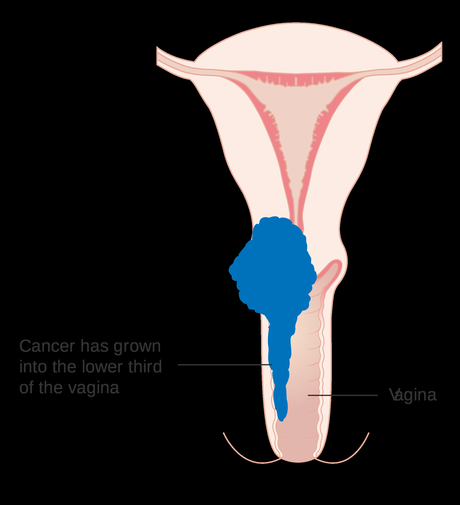
Cervical cancer generally affects women under 35 years of age. The third most common type of cancer, it had a very high death rate in the 1990's. But, the death rate has seen a gradual decrease in the recent years, thanks to the preliminary tests and screenings done in most hospitals. As the name suggests, this cancer affects the cervix, which is located at the lower part of the uterus. Cervix can also be described as the opening on top of the vagina.
what is cervical cancer
The uterine cervix is the lowest portion of a woman's uterus (womb), connecting the uterus with the vagina. Cervical cancer occurs when the cells of the cervix grow abnormally and invade other tissues and organs of the body.The Human Papilloma Virus (HPV) causes this cancer. Sometimes, this virus can stay dormant in the body for years without causing any cancerous condition. So, the person may be affected by cancer many years after she was infected. Sexual habits have a strong influence on the development and spreading of this disease. Unsafe practices include early sexual interaction, multiple sexual partners and smoking.
The early signs and symptoms that indicate the onset of cervical cancer include:
• Vaginal bleeding between menstrual periods. It should not be dismissed just as spotting, but should be checked.• Bleeding after menopause could also be a major indicator, and should be checked immediately
• Heavy menstrual flow, which could last longer than the usual period
• Severe pain during sexual intercourse
• Pale, watery or brown vaginal discharge that has a foul smell. Sometimes, the vaginal discharge may have a little blood
• Lot of difficulty defecating or urinating
• General body weakness and unexplained weight loss
• Swelling of legs
Though these signs and symptoms could indicate cervical cancer, it is always good to do a medical checkup. Pap smear tests and biopsy tests help confirm the condition. Pap smear is a very simple test that is used to study the cervical cells. While doing cancer screenings, doctors check the condition of the cervix to identify changes, if any. The oncologist will also try to observe if there are any changes in the cervical cells using biopsy tests.
The best method to prevent this disease is to do regular screenings. Women should go for pap tests from 21 years of age or after the first sexual intercourse (whichever is first). The tests should be done at least once in three years.
Like all diseases, the earlier cervical cancer is detected, the easier and the more effective treatment could become. Keeping track of the menstrual cycle, spotting any sudden changes in the regular cycles and regular medical checkup are the best ways to identify the early signs of cervical cancer.
how do you get cervical cancer
The human papillomavirus (HPV) viruses that cause cervical cancer are spread through vaginal or anal sex with an infected partner. In other words, HPV… Cervical cancer is caused by the human papillomavirus, a common sexually transmitted infection.cervical cancer risk factors
The following factors may raise a woman's risk of developing cervical cancer:
Human papillomavirus (HPV) infection. The most important risk factor for cervical cancer is infection with HPV. Research shows that infection with this virus is a risk factor for cervical cancer. Sexual activity with someone who has HPV is the most common way someone gets HPV. There are over 100 different types of HPV, not all of which are linked to cancer. The HPV types that are most frequently associated with cervical cancer are HPV16 and HPV18.Immune system deficiency. Women with lowered immune systems have a higher risk of developing cervical cancer. A lowered immune system can be caused by immune suppression from corticosteroid medications, organ transplantation, treatments for other types of cancer, or from the human immunodeficiency virus (HIV), which is the virus that causes acquired immune deficiency syndrome (AIDS). When a woman has HIV, her immune system is less able to fight off early cancer.
Herpes. Women who have genital herpes have a higher risk of developing cervical cancer.
Smoking. Women who smoke are about twice as likely to develop cervical cancer as women who do not smoke.
Age. Girls younger than 15 years old rarely develop cervical cancer. The risk goes up between the late teens and mid-30s. Women over 40 years of age remain at risk and need to continue having regular cervical cancer screenings, which include both a Pap test and HPV test.
Socioeconomic factors. Cervical cancer is more common among groups of women who are less likely to have access to screening for cervical cancer. Those populations are more likely to include black women, Hispanic women, and American Indian women.
Oral contraceptives. Some research studies suggest that oral contraceptives, which are birth control pills, may be associated with an increase in the risk of cervical cancer. However, more research is needed to understand how oral contraceptive use and the development of cervical cancer are connected.
Exposure to diethylstilbestrol (DES). Women whose mothers were given this drug during pregnancy to prevent miscarriage have an increased risk of developing a rare type of cancer of the cervix or vagina. DES was given for this purpose from about 1940 to 1970. Women exposed to DES should have an annual pelvic examination that includes a cervical Pap test as well as a 4-quadrant Pap test, in which samples of cells are taken from all sides of the vagina to check for abnormal cells.

